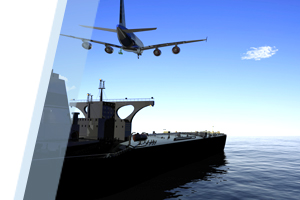
Air and Ocean Shipping Options: The Strategy of Modal Shifts
This content was updated in June 2019
You make decisions all day every day. And if you’re in the logistics business, one of those decisions is probably about how you want to transport your goods. Sometimes this decision is straightforward, yet when global shipping needs and tight timelines collide, the choice may become far more challenging.
Both air freight and ocean shipping, the two most popular methods to ship goods across continents, have advantages to consider before choosing one or the other.
Air freight vs. ocean shipping
Determining the ideal mode of transportation for your freight requires ongoing analysis. A one-time review of your supply chain needs won’t be sufficient to keep your supply chain efficient and cost effective.
No matter which method you choose, working with a provider who offers a full suite of global logistics and technology services can help ensure the method you want is available when you need it most.
Be sure to consider the following when evaluating whether air freight or ocean shipping is the best option to meet your current transportation needs.
Cost is based on freight characteristics
While it may seem like ocean shipping is always cheaper than air freight, you first need to understand how each is billed.
Air freight is billed through chargeable weight, which is a metric calculated by combining the weight and size of the shipment. In ocean shipping, shipment weight is not usually factored in. Instead, ocean shipping is billed by container—a full standard container (20’ x 40’) is charged a flat rate. Less than container loads (LCL) are billed by cubic meter.
For large, heavy shipments, shipping via ocean is often much less expensive. But as shipment sizes decrease, the margin between air and ocean prices also decreases.
But the actual cost of transportation is only the beginning. You also need to calculate inventory costs. Warehousing fees related to ocean shipping tend to be more expensive than warehousing fees at airports.
Keep in mind that both modes of transportation will face customs and destination fees when shipping internationally.
Speed varies greatly by mode
Air freight is faster than ocean shipping, hands down. Ocean shipments can sometimes take weeks to arrive. Air freight can reach its destination in only a day or two. While ships are getting faster and ocean shipping routes are being constantly optimized, there is still no beating the speed of air freight.
Faster delivery times are quickly becoming expectations across many industries, but before immediately shipping everything by air, take the time to strategically plan out your shipping strategy. It will create long-term efficiencies and save you money.
Reliability can be achieved through both modes
Airlines are typically better at handling schedule changes than ocean carriers. Factors like weather conditions can throw off airline schedules far more easily than ocean journeys, but flights tend to be rearranged and rescheduled quickly and efficiently. Additionally, there are usually multiple flights each day between major cities, while ships tend to leave weekly.
This does not necessarily mean that air freight is always more reliable than ocean freight. When ships are thrown off schedule, they tend to need a few days to get back on top of their operations. However, ongoing alliances between ocean carriers can build reliability and integrity for ocean service, which makes ocean shipping an appealing option—even for some time-sensitive freight like perishables, fashion, and auto parts.
Complexities of ocean alliances may affect service
While the alliances between ocean carriers produce increased reliability, those same alliances can cause complications. For example, if three ocean carriers work together, one week you may have a vessel from one carrier, and another week you have the same vessel but a different carrier. Each carrier has their own set of rules about what commodities are allowed. So even by shipping the same product on the same vessel every week, if a different carrier is in charge, there is a possibility that your product could be denied because the rules have changed.
Should you use air freight or ocean shipping?
Typically, the number one reason to choose air service is the speed of delivery. Moving your cargo through the air allows for a truncated timetable compared to ocean service. This is particularly useful when shipping items with short shelf lives. However, the price for faster service is often higher transportation costs. It’s up to you to determine what makes sense for your shipping strategy.
So, which should you choose? Evaluate when your goods need to arrive at their destination, what your budget is, and how each mode will affect your business’s top needs.
If your shipments have a hard, quickly-approaching arrival deadline and your budget allows, ship via air. If you have more arrival date flexibility or want to save money, ship via ocean.
Final thoughts
If you’re having trouble making optimal shipping decisions, trust a third party logistics provider (3PL), like C.H. Robinson, to help. Choose a 3PL that has the scale to consolidate your air and ocean freight with others for better cost efficiency. The best global providers bring their experience of working with the largest, most sophisticated shippers in the world and apply it to your success.
Learn more about how an experienced 3PL can help your business optimize your global shipping processes, whether you choose to use ocean shipping or air freight.



